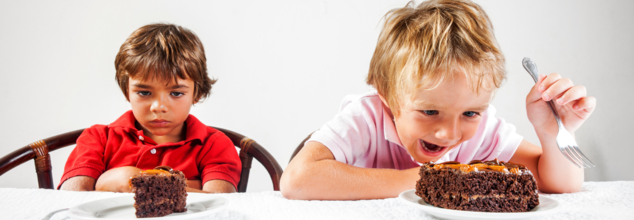- Health Conditions A-Z
- Health & Wellness
- Nutrition
- Fitness
- Health News
- Ayurveda
- Videos
- Medicine A-Z
- Parenting
- Web Stories
Parents Do Play Favorites - Research Finds What Is The Key To Favoritism Among Parents

(Credit-Canva)
While parents often claim they do not have a favorite child, sometimes their favor is evident. Sometimes it is the kid they depend on the most, other times it is the youngest kid of the family. However, is there a specific factor parents enjoy more in their kids? After analyzing factors like age, gender and behavioral pattern, researchers found what parents favored the most in their children
In a 2025 study published by the Psychological Bulletin, researchers found that parents favor daughters. They are more likely to be the favorite, across both mothers and fathers. Firstborn children also often receive more positive attention. Additionally, children who are described as conscientious – meaning they are responsible, organized, and do what they're supposed to – are also frequently favored. These findings suggest that certain personality traits and birth order can influence how parents interact with their children, even if unintentionally.
How Did They Find Parents Favored Certain Kids
Researchers looked at the results of many different studies. They combined the findings from over two dozen research papers, including articles, school projects, and large collections of data. This allowed them to see broader patterns in how parents treat their children differently. By looking at things like how much affection parents show and how they share resources, the researchers could draw more reliable conclusions than if they had just looked at one single study. This big picture approach helps us understand the common trends in parental favoritism.
Why Did The Parents Favor These Traits
Older Siblings
Parents tend to grant older children more freedom and decision-making power, likely due to perceiving them as more mature and responsible based on their age and experience. Having navigated earlier developmental stages, they've often earned more trust, leading parents to offer greater independence compared to their younger siblings who are still learning and growing.
Daughters
Social norms and potential emotional closeness might contribute to daughters being favored. Parents may have different communication styles or expectations, possibly leading to a stronger perceived bond. While conscientiousness and agreeableness play a role overall, a general inclination towards daughters could also stem from subtle societal influences on parental perceptions and interactions.
Conscientious and Agreeable Children
Children who are responsible, organized, cooperative, and kind often experience more positive parental interactions. Their agreeable nature leads to less conflict, creating smoother relationships. These traits can make parenting easier, resulting in more praise, trust, and overall favored treatment compared to siblings who may exhibit more challenging behaviors.
Avoiding Shows Of Favoritism For Kid’s Well-Being
When children feel like they are not the favorite, it can have a real impact on their well-being. It's not just about feeling a little sad; it can affect their mental health, their relationships with others, and even how well they do in school. To make sure all their children feel equally loved and valued, parents can try a few practical things.
It's helpful for parents to regularly think about how they interact with each child. Showing interest in each child's unique hobbies and asking them open-ended questions about what's important to them can make a big difference.
Spending dedicated one-on-one time with each child and avoiding comparisons between them are also key. Encouraging a positive relationship between siblings and openly talking about everyone's needs can create a more supportive and equitable family environment.
Tips For New Moms To Stay A Step Ahead Of Breast Cancer, According To Doctor

Credits: Canva
As a new mom a lot of things run through in the head. Not just child's health, but also your health too. As it is a very new experience. One of the newest experience could be breast feeding, and the thought of breast cancer and many such questions may occur.
Is There Any Link Between Pregnancy And Breast Cancer?
As per the National Institutes of Health, US, the risk of breast cancer, is in fact reduced by 4.3% for every 12 months of breastfeeding. This is in addition to 7.0% decrease in risk observed for each birth. However, notes a 2011 study published in the Journal of Turkish-German Gynecological Association, breast cancer risk is higher within the 3 to 15 years of term delivery. This increased risk is specific for women whose first delivery occurred after 30 years of age.
The study notes that women who delivered their fist baby at ages younger than 25, did not have any breast cancer risk, or had a very small increase. However, a transient increase was seen within 10 to 15 years of delivery and after that a protective effect of delivery is seen.
Among women who delivered their first baby before 25 years of age, the life time breast cancer risk actually decreased 36% after the period of transient increase.
However, new mothers who are at risk may find it difficult to distinguish between normal lactation-related issues and potential warning signs of breast cancer, including discharge from breast, and more.
To understand this better, we spoke to Dr Prachi Sarin Sethi, Gyencologist & Laparoscopic surgeon, Motherhood Hospitals, Gurugram. Here's what she told us:
"All new moms need to be aware that changes in the breast during lactation are common, but awareness is key," she pointed out.
Blocked Ducts And Mastitis Vs Suspicious Lumps: How to Differentiate?
"Many breastfeeding mothers experience blocked ducts, which can cause small, tender lumps in the breast," said Dr Sethi. To understand the symptoms, it is important to understand first what they mean.
Mastitis means an infection of the breast tissue that could lead to redness, swelling, warmth, pain, and even fever. "These conditions are temporary and resolve with rest, warm compresses, and proper breastfeeding techniques," she points out.
However, it is important to know that not all lumps are related to breastfeeding. Suspicious lumps can be hard, irregular in shape, painless, or persist beyond a week. This is when the woman must go to a doctor, she points out.
"Changes in the nipple, skin dimpling, or unusual discharge will also indicate that a woman needs medical attention."
The doctor notes that routine breast checks after the delivery must be done as it allows one's doctor to examine the breast tissue and guide the patient on proper self-examination techniques. This could also allow early identification of abnormalities, and improve the treatment outcomes.
"New moms should be encouraged to perform regular self-checks, observe changes in shape, texture, or skin appearance, and lumps. Keeping a record of any persistent changes or discomfort is helpful during consultations."
What Is The Trophy Child Syndrome That Pressurizes Kids To Be Reflection Of Their Parents' Success?

Credits: Canva
Think of when you go to someone's house who has a kid. What is the first thing that happens? The kid is asked to sing, dance, or recite a poem for the guests. If the kid does it, he or she receives applause, and the parents become instantly happy. If the kid fails to do so or hesitates, while the parents smile, and behind it is a pattern that child psychologist call the Trophy Child Syndrome.
This happens when parents view their child's talents, grades, or charm as the reflection of their own. While this may seem like a common, everyday household, tradition, it bears a lasting impact on the child. This is what experts call the 'showcase parenting'.
What Is A Trophy Child?
Paul Opiyo, who writes for Medium says that when a child is exceptionally good at something his or her success is often put at par with parent's reflection. However, this comes in many shapes, for instance, writes Opiyo, if the child shows great athletic talent, the parents initiate a 'Project Mbappe', or when the child demonstrates intellectual gifts, the parents shove a 'Project Einstein' on them.
In other parents, from very early on the child discovered that it is not them or their personality, but actually what they do is what's considered important.
This is true especially in households with parents who have high narcissistic traits, who are controlling or who are enmeshed. This is where the child is seen just as the extension of a parent and nothing more than that. This forms predictable patterns of family dynamics. The family operates on winning love and approbation. This is not just a competition, but a habit, that gets amped up and becomes the standard by which family members are judged.
Are There Signs Of A Trophy Child?
While the child may recognize that he or she is a trophy child, there could be many signs that may hint towards those.
Perfectionism
The child has a strong need to be perfect at everything they do. The child is also highly sensitive to criticism, because any mistake to the child feels like a failure to meet expectations.
People Pleasing
The child has a hard time saying 'no', this is because the child has had a habit of seeking validation from others.
External Validation
The child's self worth is also tied to their accomplishments and achievements, which are only celebrated outside, and not private goals. The child learns to feel valuable only when there is something that the child is 'winning' at.
Loss Of Identity
In the race to become someone else or to behave like someone else, personal goals or the child's own interests often gets sidelined. this could lead to a weak sense of self.
Experts point out that these kids internalize the message that they are valued for what they do and not who they are. This very feeling creates deep insecurities in them as they enter adulthood. Because even after they have grown up, they feel the constant pressure to prove their worth.
Experts also point out that social media has further fueled fire to this. Thanks to social media, many parents are asking their kids to do certain things, record it online and upload it for likes and views.
However, there is a way to break the cycle, the first step is to acknowledge that this is happening with you and then to approach a practitioner.
Study Shows THIS Is What Parents Should Do In The First 1000 Days Of A Child's Birth To Prevent Childhood Obesity

(Credit-Canva)
Childhood obesity is a growing global health problem. According to the World Health Organization, in 2024, 35 million children under the age of five were overweight. While many parents ignore the issue, assuming children will lose weight as they grow, childhood obesity is linked to numerous adulthood problems, including a higher risk of heart disease and hypertension.
However, how much of the fault lies in the children, is it just because of their diet and willingness to stay active?
A new and significant study by a European research group, the EndObesity Consortium, has made a surprising discovery: they think this health crisis might actually start even before a baby is even conceived. This group of scientists has been searching for new and effective ways to stop the rising number of children who are becoming obese.
What Role Does Parenting Play in Childhood Obesity?
The study identified a critical period called the “first 1,000 days,” which it says is the most important window to prevent childhood obesity. The scientists, whose work was published in the Pediatric Obesity journal, explain that this key window begins before the child is conceived and lasts until the child turns two years old.
The researchers found that the health programs currently used to fight obesity by changing people's habits are usually put into place too late. Also, these programs often fail to deal with the social and economic problems that make it hard for people to lose weight. Because of this, the study suggests a much wider plan is needed. This plan would involve both parents making healthy changes before they conceive a child and also include big changes to government policies.
How To Change Your Lifestyle To Beat Obesity?
The researchers are convinced that the period from before conception until the child is two is the absolute best time to focus on stopping obesity. They noted that simply telling people to make lifestyle changes right now hasn't worked well. They argue that we need a solution with many parts. This solution must mix personalized help for families with supportive government rules, which could include things like:
- Regularly checking families for obesity risks.
- Teaching the public more about healthy habits.
- Creating places and rules that make living a healthy life easy right from the start.
What are The Risk Factors Of Childhood Obesity?
This new approach aims to stop the problem of obesity being passed from parents to children. The research team listed several ways the mother's and father's lifestyle before conception could increase the child’s risk of obesity:
- The parent being overweight or obese themselves.
- The mother gaining too much weight during pregnancy.
- Eating a diet that is unhealthy, high in fat, and full of sugar.
- Not getting enough essential vitamins and minerals.
- Not getting enough physical activity or exercise.
- Smoking.
- Having high levels of stress.
Once the baby is born, other things can affect their risk of becoming obese, such as:
- Not breastfeeding or having issues with it.
- Using baby formula that isn't ideal.
- The child gaining weight too fast.
- An unhealthy diet during the first years of life.
- Poor quality sleep.
Do Obese Parents Affect Child’s Health?
Research shows that parental obesity increases the likelihood of children also becoming obese, creating a challenging cycle.
This link happens because adults who carry too much weight have a higher risk of health issues like Type 2 diabetes and heart disease. These conditions can negatively affect the health and quality of a woman's eggs and the environment inside her ovary. This in turn can hurt the earliest development of the fetus, which is how the cycle of obesity risk begins for the next generation.
© 2024 Bennett, Coleman & Company Limited

